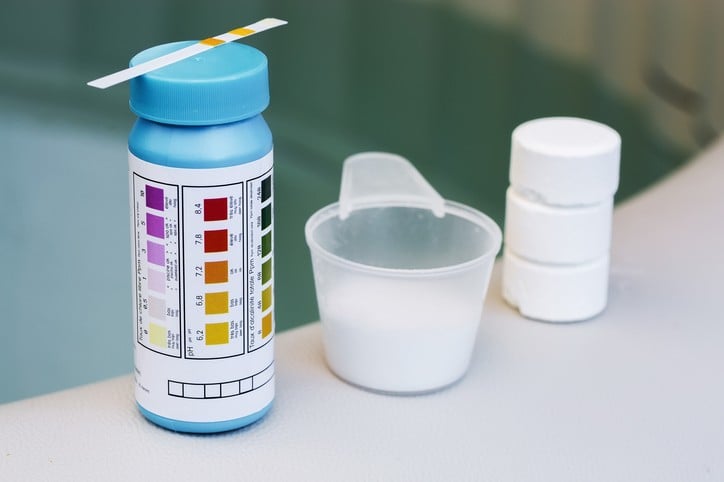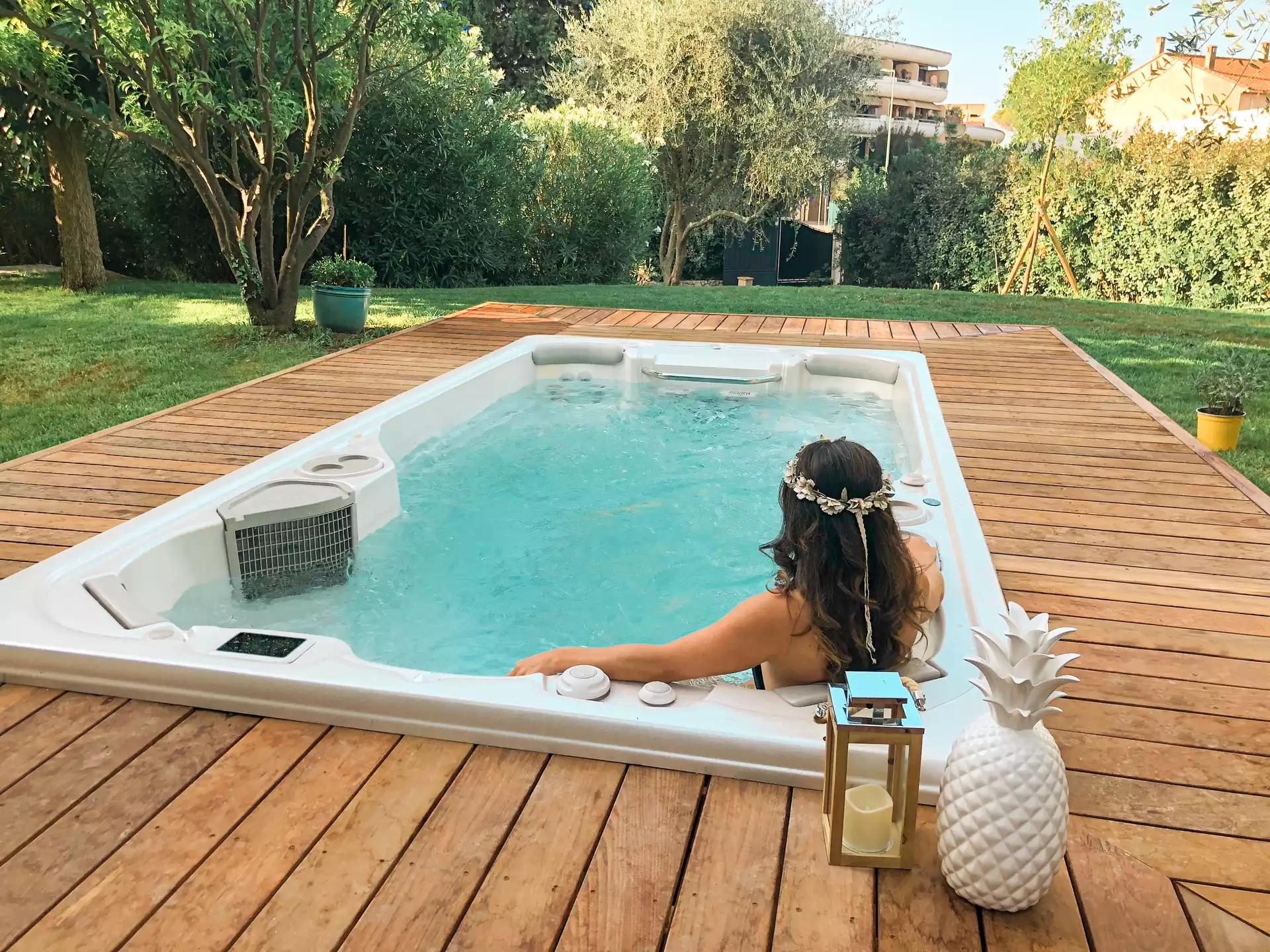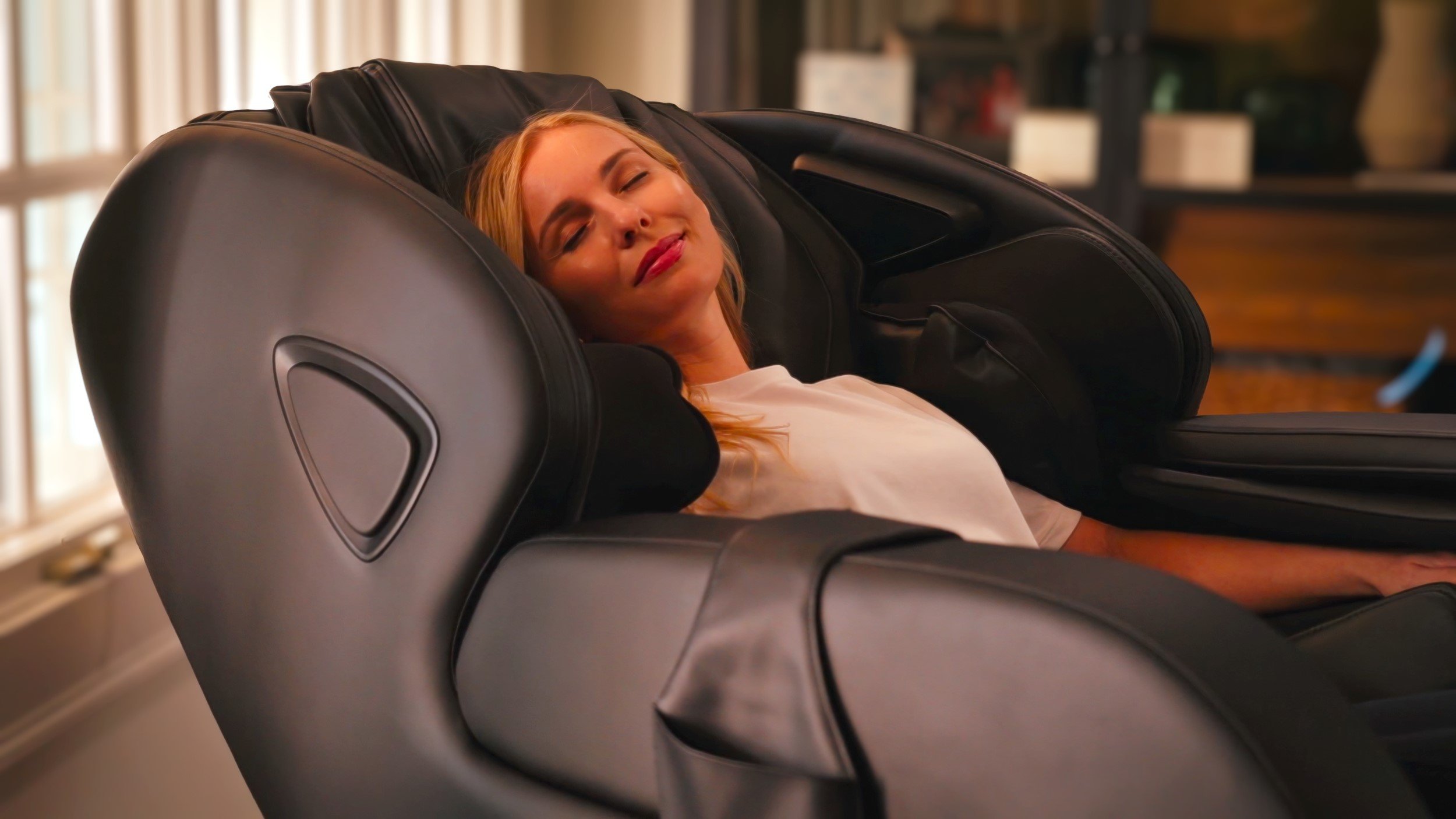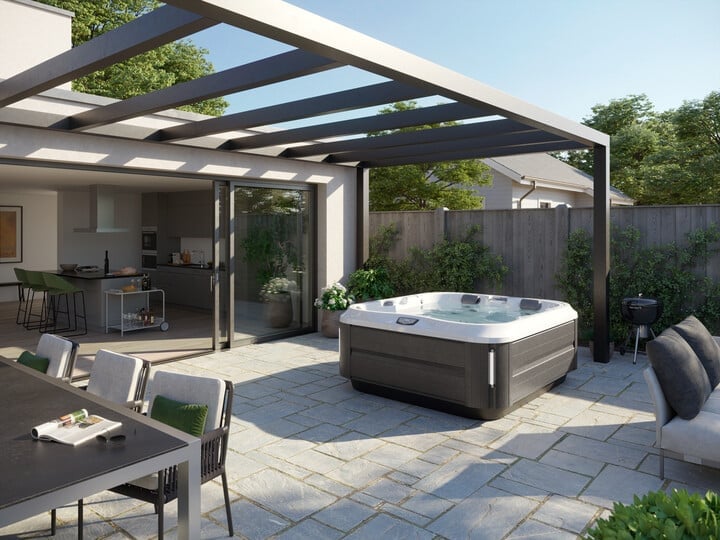Learning how to properly treat your hot tub water can be challenging, especially with so many hot tub chemicals on the market.
How do you know which ones you need?!
The truth is some chemicals are essential, while others are optional additions or are only needed based on the water quality in your area.
The only way to learn what chemicals you need to effectively maintain your hot tub water is by monitoring your water quality and testing its levels regularly.
This guide will be breaking down the essential hot tub chemicals you’ll need to maintain your water’s chemistry and outline some additional additives you may find helpful in the future.
Hot Tub Chemical Essentials
The list of hot tub chemicals on the market is long, and knowing which ones you need is important in keeping cloudy or smelly water at bay.
Keep reading to find out which chemicals you should invest in before your hot tub arrives!
Alkaline and pH Treatment
Have you ever looked at the taps in your house and noticed hard, mineral buildup on them? What about water stains on your glasses after they come out of the dishwasher?
This is a direct result of the water quality in your area. Some people will have naturally soft water, while others will experience hard water that’s filled with calcium.
When it comes to your hot tub, you’ll need to test your water to discover its pH and alkaline levels. Essentially, these levels determine if your water is soft or hard. If you have high alkaline levels, your water will be hard, whereas soft water will have a low pH level.
These levels need to be kept within a certain range to ensure your water isn’t harming your hot tub parts and that it’s safe to soak in.
Your pH should always remain between 7.2 and 7.8, while your alkaline levels should be between 80-100 ppm (parts per million).
If your water has low pH levels, it’s too soft or “basic,” essentially meaning it’s become acidic, which can result in your water eating away at your hot tub parts, corroding your shell and heating elements.
If it has a high alkaline level, it’s too hard, resulting in a hard scale forming on every surface your water comes in contact with.
This is why including pH and alkaline treatments in your regular water treatment routine is essential.
You’ll need three chemicals to maintain your pH and alkaline levels:
- pH Increaser
- pH Decreaser
- Total Alkalinity Increaser
After testing your water with pH strips, you can add your treatment products as needed to bring everything back into range. This is particularly important after you’ve performed a water change.
Before adjusting your pH levels, focus on your alkalinity. As you adjust your alkaline levels, your pH levels will fluctuate as well.
Alkalinity significantly influences the pH in your water, but pH only has a minor influence over alkalinity. Bringing your alkaline levels into range first will ensure you don’t over-treat your water.
Sanitizer
Your sanitizer works to break down bacteria in your water, ensuring it’s clean and safe to use.
There are four main sanitizers on the market, and which one you use will depend on your hot tub’s water system.
1. Biguanide
This sanitizer is one of the only chlorine-free options on the market. Biguanide is an odorless chemical and helps create a silky smooth soaking experience.
While it’s a great solution if you have a chlorine sensitivity, it’s also a more expensive water treatment option, making it costly to maintain your spa.
If you use biguanide, you should maintain their levels at 30 to 50 ppm.
2. Bromine
Bromine is an alternative to chlorine and is the second most common sanitizing option among hot tub owners.
One of the benefits of using bromine is that it doesn’t produce chloramines, the byproduct of chlorine that produces the distinctive “chlorine smell” you’d find at the public pool.
While bromine is as effective at treating your water as chlorine, it does have one disadvantage.
Bromine breaks down significantly faster than other sanitizers when exposed to the sun. This can lead to additional bromine being needed to maintain your sanitizer levels, which can become costly.
When using bromine, your sanitizer levels should stay between 3 to 5 ppm.
3. Chlorine
Chlorine is the most commonly used sanitizer for hot tub and pool owners across the country, and for good reason.
Chlorine is:
- Highly effective in killing bacteria
- Easy to use
- Inexpensive
As mentioned above, as chlorine cleanses your water, it produces a byproduct called chloramines. This is what gives chlorine its smell.
In reality, your hot tub water should never really smell like chlorine. If it does, it likely means your sanitizer levels are too high, your pH is unbalanced, or you have too many chloramines in your water.
Fixing this is as easy as testing your water and treating it as necessary.
If your chlorine levels are too high, turn on your jets and let your water off-gas. If your chlorine is within the expected range, either add an oxidizing treatment or rebalance your pH if it’s not within 7.2 and 7.8.
Your chlorine levels should always be between 1-3 ppm.
To raise the chlorine in your spa, watch this helpful video!
4. Salt
Saltwater systems have risen in popularity over recent years, with many believing they’re a chlorine-free sanitizing solution.
However, this isn’t exactly accurate.
Saltwater spas still have chlorine in their water. These systems use salt cells to clean the water, and as the water moves through the cells, the salt is broken down into various chemicals, one being chlorine.
While the chlorine levels in your water may be lower, it certainly isn’t chlorine free.
One of the benefits of saltwater hot tubs is the soft, gentle soaking experience they provide, with many people finding their skin less tight and their hair less brittle after a soak in their saltwater spa.
Oxidizer
Oxidizers are an important chemical to include in your routine, especially if your hot tub sees a lot of use.
This chemical works to break down oils and organic matter that have contaminated your water. These oils generally come from:
- Make-up
- Body lotions
- Hair products
- Dead skin cells
Your sanitizer cannot effectively break down these types of contaminants, and if left to build up in your water, you may discover it’s gone cloudy or is beginning to foam when the jets are turned on.
Adding an oxidizing shock treatment can help combat these organic contaminants, working alongside your sanitizer to ensure your water is fully cleaned and ready for you to use.
Optional Hot Tub Chemicals
Over the first few months of having your spa, you may discover that your current hot tub chemicals are unable to effectively keep your water healthy long-term.
This is when you can begin considering adding some extra chemicals to your regular maintenance routine.
Calcium
If you live somewhere with softer water, you’ll likely need to use a calcium increaser to help keep your water balanced and combat corrosion.
Ideally, your water hardness should be between 175 ppm and 250 ppm.
Clarifier
A water clarifier can be helpful if you need to manage dirty water fast, like if you’re having a party that night or are dead set on enjoying an evening soak after a particularly difficult day.
The issue with clarifiers is that it’s not technically a treatment method. It’s more of a temporary way to mask the issue. It’ll clear up cloudy or foamy water quickly, but only for a short amount of time before your problems return.
Enzymes
Adding an enzyme treatment to your water can help combat organic matter as it enters your system.
If you use your hot tub often or enjoy throwing exciting hot tub parties, including an enzyme treatment can help reduce the risk of cloudy or foamy water forming in the future.
How to Properly Add Hot Tub Chemicals to Your Water
Now that you know the hot tub chemicals you should have on hand, it’s important to know how to add them to your water.
Follow these steps anytime you’re adding chemicals to your water.
1. Test Your Water Before Beginning
You’ll want to know your water’s current alkalinity, pH, and sanitizer levels before treating it. You can do this using test strips, a water treatment kit, or a digital meter.
2. Follow the Instructions Closely
Every hot tub chemical should have specific instructions listed on its bottle. Carefully read these before adding them to your water, and follow their instructions closely to ensure you don’t cause damage to your spa.
3. Leave the Cover Off for 30 Minutes
As your chemicals treat your water, they will produce gas. This gas needs space to evaporate, so it doesn’t reenter your water and leave you with sky-high chemical levels, making your water unusable.
Keeping your cover off after treating your water will help ensure your water can off-gas while your chemicals do their job.
4. Keep Your Hot Tub Running
Your hot tub jets will need to be running as you add your chemicals. This will ensure that they are able to properly mix into the water.
Keep your jets running for 15 minutes after you’ve added any chemical treatments.
5. Turn Off the Air Valves.
If there is too much air being introduced into your water as your chemicals are working to treat it, you risk off-gassing them too quickly. This can lead to additional chemicals needing to be added, unnecessarily raising your maintenance costs.
6. Always Measure Twice
If you add too much of any of your chemicals, it can be challenging to bring their levels back down again, leading to frustratingly long wait times before your next soak.
Measuring your chemicals twice before adding them to your water will help ensure you don’t accidentally over treat your water.
7. Retest Your Water
After you’ve given the chemicals time to work, re-test your levels and make any final adjustments.
You don’t want to soak in poorly balanced water, so it’s essential to always test it before climbing in for a relaxing soak.
Hot Tub Chemicals in Utah
With four showrooms across Utah, Red Rock Spas has a convenient location near you that’s stocked with top-of-the-line hot tubs, swim spas, and treatment essentials.
Visit your local showroom, or contact us today to find the hot tub chemicals you need to make caring for your hot tub easy!
Need hot tub chemicals right away? Visit our online store!









